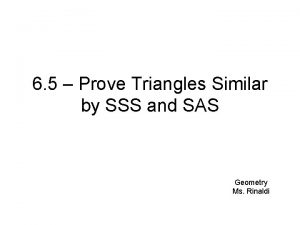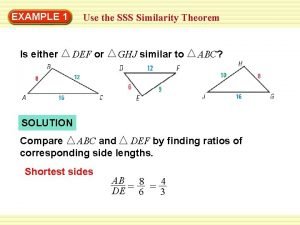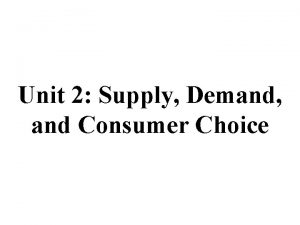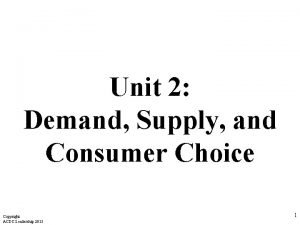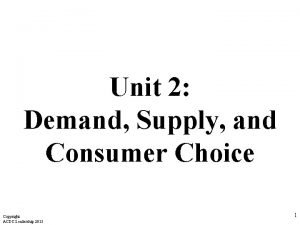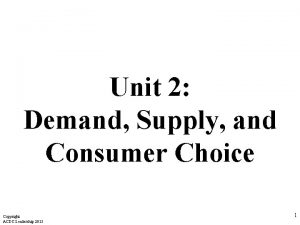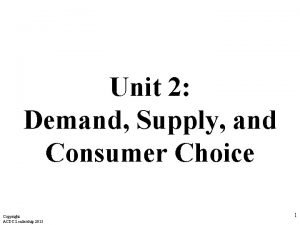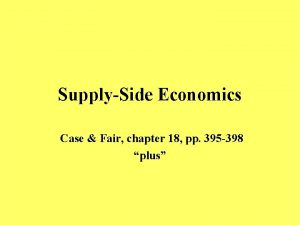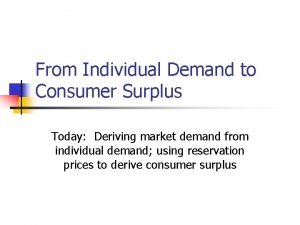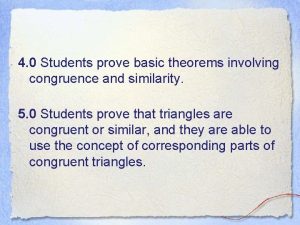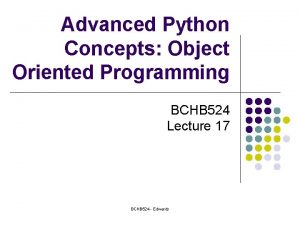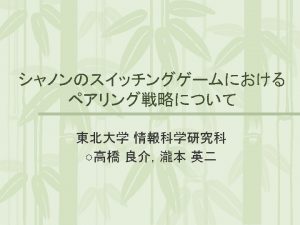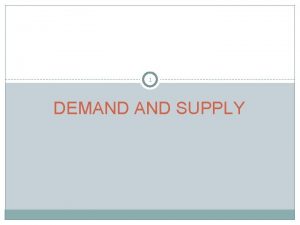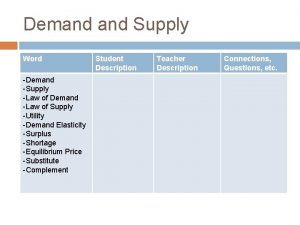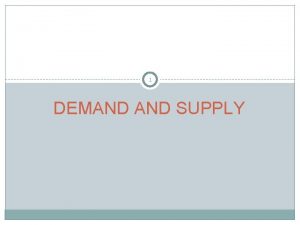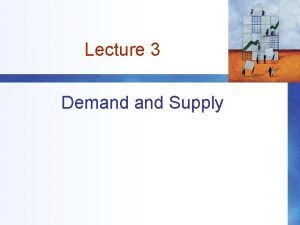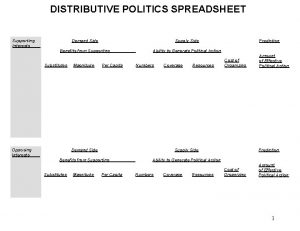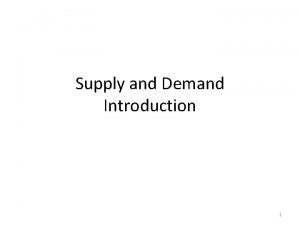2 Supply and Demand Outline Demand consumer side





































- Slides: 37

2 Supply and Demand

Outline ● Demand –consumer side of the market ● Supply –seller side of the market ● Equilibrium –how prices and quantities are determined by the market ● Changes in equilibrium –shifts in D and S ● Price ceilings and price floors –government’s attempt to restraint or bolster prices Copyright© 2006 South-Western/Thomson Learning. All rights reserved.

Demand Quantity Demanded ● Quantity of demand = the amount that buyers wish to purchase at each price ● Qd depends on P, population size, consumer incomes, tastes, and P of other products ● D focus only on relationship between P and Qd ● Consider D schedule for milk –table showing the Qd at each P Copyright© 2006 South-Western/Thomson Learning. All rights reserved.

1. Demand Schedule for Milk TABLE Copyright© 2006 South-Western/Thomson Learning. All rights reserved.

Demand Quantity Demanded ● The Demand Curve ♦ Graph of a demand schedule ♦ Negative slope ■ As ↑P milk ↓Qd milk because: 1. People consume less milk. 2. Some people drop out of the market for milk and drink tea or orange juice instead. Copyright© 2006 South-Western/Thomson Learning. All rights reserved.

1. Demand Curve for Milk FIGURE Price per Quart D $1. 50 A B 1. 40 C 1. 30 E 1. 20 F 1. 10 G 1. 00 H . 90 0 D 45 50 55 60 65 70 75 Quantity Demanded in Billions of Quarts per Year Copyright© 2006 South-Western/Thomson Learning. All rights reserved.

Demand Quantity Demanded ● Along D curve all other determinants of Qd for milk (e. g. , consumer incomes, P orange juice, or P cereal) are held constant. P of milk is the only determinant of D for milk that is allowed to . ● Law of Demand the lower P of the good, the larger Q consumers wish to purchase. In general, D curves have a (-) slope. Copyright© 2006 South-Western/Thomson Learning. All rights reserved.

Demand Quantity Demanded ● Shifts of the Demand Curve ♦ Movement along a fixed demand curve: ■ Price ♦ Shift in the entire demand curve: ■ Incomes ■ Population ■ Preferences ■ Prices and availability of related goods Copyright© 2006 South-Western/Thomson Learning. All rights reserved.

2. Movement along vs. a shift in the Demand Curve FIGURE Movement along: A to B (or C to D) D 1 Outward shift: A to C (and B to D) Price per Quart D 0 A $1. 30 C D B 1. 10 D 1 D 0 55 65 70 80 Quantity Demanded in Billions of Quarts per year Copyright© 2006 South-Western/Thomson Learning. All rights reserved.

Factors that shift demand 1. ∆ income: ● ● Normal goods: ↑ income shifts D out Inferior goods: ↑ income shifts D in Ø What are some examples of inferior goods? Copyright© 2006 South-Western/Thomson Learning. All rights reserved.

Factors that shift demand 2. ∆ P of related products: a) Two goods are compliments if they are consumed together. ● ↓P of a compliment shifts D out ● E. g. , ↓P cereal shifts D milk out What will happen to D for milk if ↑ P oreos? Copyright© 2006 South-Western/Thomson Learning. All rights reserved.

Factors that shift demand 2. ∆ P of related products: b) Two goods are substitutes if one can replace the other in consumption. ● ↓P of a substitute shifts D in ● E. g. , ↓P orange juice shifts D milk in What will happen to D for milk if ↑ P tea? Copyright© 2006 South-Western/Thomson Learning. All rights reserved.

Factors that shift demand 3) ∆ tastes: ♦ If consumers worry about their daily calcium intake D milk shifts out ♦ As population ages D milk shifts in Why have we seen a rise in the number of milk ads? 4) ∆ population: ♦ If the size of the population increases D milk shifts out. Copyright© 2006 South-Western/Thomson Learning. All rights reserved.

Supply and Quantity Supplied ● Quantity of supply = amount that producers wish to sell at each price ● Qs depends on P, size of the industry, P of inputs, and technology. ● S focus only on relationship between P and Qs ● Consider S schedule for milk –table showing the Qs at each P Copyright© 2006 South-Western/Thomson Learning. All rights reserved.

2. Supply Schedule for Milk TABLE Copyright© 2006 South-Western/Thomson Learning. All rights reserved.

Supply and Quantity Supplied ● The Supply Curve ♦ Graph of a supply schedule ♦ Positive slope ■ Farmers require ↑P milk to ↑Qs because ↑costs as they produce more ● Higher milk prod. requires more cows, feed, milking equipment, dairy workers, etc. Suppliers want to make profits, so they raise P to cover their costs. Copyright© 2006 South-Western/Thomson Learning. All rights reserved.

3. Supply Curve for Milk FIGURE a $1. 50 S b Price per Quart 1. 40 c 1. 30 e 1. 20 f 1. 10 g 1. 00. 90 0 h S 30 40 50 60 70 80 90 Quantity Supplied in Billions of Quarts per Year Copyright© 2006 South-Western/Thomson Learning. All rights reserved.

Supply and Quantity Supplied ● Along S curve all other determinants of Qs of milk (e. g. , P feed, weather, wages of dairy workers) are held constant. P of milk is the only determinant of S of milk that is allowed to . ● Law of Supply the higher P of the good, the larger Q firms want to produce. In general, S curves have a (+) slope. Copyright© 2006 South-Western/Thomson Learning. All rights reserved.

Supply and Quantity Supplied ● Shifts of the Supply Curve ♦ Movement along a fixed supply curve: ■ Price ♦ Shift in the entire supply curve: ■ Size of the industry ■ Technological progress ■ Prices of inputs ■ Prices of related outputs Copyright© 2006 South-Western/Thomson Learning. All rights reserved.

4. Movement along vs. a shift in the Supply Curve FIGURE Movement along: A to B (or C to D) S 0 Price per Quart Outward shift: A to C (and B to D) S 1 B $1. 30 D A 1. 10 C S 0 S 1 50 70 75 95 Quantity Supplied in Billions of Quarts per Year Copyright© 2006 South-Western/Thomson Learning. All rights reserved.

Factors that shift supply 1. Size of the industry: ● ↑number of firms shifts S out What happens to the S milk if the number of dairy farms decreases? 2. Price of inputs: ● ↓price of an input shifts S out What happens to the S milk if dairy workers unionize and negotiate higher wages? Copyright© 2006 South-Western/Thomson Learning. All rights reserved.

Factors that shift supply 3. Technological progress: ● Improvements in technology shifts S out ● Example: many dairy farmers use BGH to ↑output of milk per cow. 4. ∆ Prices of related products: ● ∆ P of 1 good produce a multi-product industry can shift S curve of other goods produced by that industry. ♦ E. g. , if ↑P cheese shifts S milk in Copyright© 2006 South-Western/Thomson Learning. All rights reserved.

Supply and Demand Equilibrium ● In a free market, Q of goods and services is determined by the intersection of S and D. ● E consumers are willing to buy exactly what producers are willing to sell Copyright© 2006 South-Western/Thomson Learning. All rights reserved.

3. Equilibrium Price & Quantity of Milk TABLE Copyright© 2006 South-Western/Thomson Learning. All rights reserved.

Supply and Demand Equilibrium ● E occurs where Qs = Qd = 60 at P = $1. 20 ● If P > PE surplus (with Qs > Qd). Surplus ends with frustrated sellers ↓P to reduce inventories. ● If P < PE shortage (with Qd > Qs). Shortage ends with frustrated consumers offering ↑P to obtain the good. Copyright© 2006 South-Western/Thomson Learning. All rights reserved.

5. Supply-Demand Equilibrium FIGURE D a A $1. 50 S Price per Quart 1. 40 1. 30 E 1. 20 1. 10 g G 1. 00. 90 0 D S 30 40 50 60 70 80 90 Quantity in Billions of Quarts per Year Copyright© 2006 South-Western/Thomson Learning. All rights reserved.

Adjustment to Shifts in Demand ● Any shift in S or D E ● Shifts in Demand ♦ Shifts in D equilibrium P and Q in the same direction ■Example: any inward shift in D lowers equilibrium P and Q. Copyright© 2006 South-Western/Thomson Learning. All rights reserved.

6. Inward shift in the Demand Curve FIGURE 1 to 2: D shifts in. Price per Quart D 0 S D 2 Surplus ends as ↓P. 1 $1. 20 2 3 1. 10 D 0 S Point 2: surplus of 15 as Qd < Qs. D 2 45 50 60 Quantity ↓P encourages ↑Qd (2 to 3) and ↓ Qs (1 to 3) which ends the surplus. Point 3: new E. Copyright© 2006 South-Western/Thomson Learning. All rights reserved.

Adjustment to Shifts in Supply ● Shifts in Supply ♦ Shifts in S equilibrium P and Q in opposite directions ■Example: any inward shift in S lowers equilibrium Q and raises equilibrium P. Copyright© 2006 South-Western/Thomson Learning. All rights reserved.

7. Inward shift in the Supply Curve FIGURE 1 to 2: S shifts in. S 2 Point 2: shortage of 22. 5 as Qs < Qd. Price per Quart D 3 $1. 40 S 0 Shortage ends as ↑P. 1 2 1. 20 ↑P encourages ↓Qd (1 to 3) and ↑Qs S 2 S 0 D 37. 5 50 60 Quantity (2 to 3) which ends the shortage. Point 3: new E. Copyright© 2006 South-Western/Thomson Learning. All rights reserved.

Government Intervention in Markets: Price Ceilings ● A price ceiling is a legal maximum on the price that may be charged for a good. ■ Example: Rent control in NY City 1. Persistent shortage develops as Qd > Qs ♦ Low vacancy rate (1/2 national average) 2. “Black” markets arise with higher prices ♦ “Key money” to move up on wait lists or forced to buy wretched furniture at high P Copyright© 2006 South-Western/Thomson Learning. All rights reserved.

Price Ceilings 3. Illicit suppliers get substantial portion of P ♦ E. g. , theater ticket P controls in NY City 4. Investment in the industry dries up ♦ ♦ ♦ Convert apartments to office space or condos Inadequately maintained apartments Abandoned buildings With all of these problems, why have rent controls in NY City continued since WWII? Copyright© 2006 South-Western/Thomson Learning. All rights reserved.

8. Rent Control FIGURE S Rent per Month D $2, 000 1, 200 Market rent Rent ceiling E C B S 0 D 2. 5 3 3. 5 Millions of Dwellings Rented per Month Copyright© 2006 South-Western/Thomson Learning. All rights reserved.

Government Intervention in Markets: Price Floors ● A price floor is a legal minimum on the price that may be charged for a good. ■ Examples: min. wage and agricultural P supports 1. Persistent surplus develops ♦ E. g. , EU with CAP. Europeans export surplus; lowers world food Ps and fuels trade disputes with U. S. 2. Disposal problems ♦ E. g. , Gov. has to purchase, store, and dispose of the agricultural surplus. Copyright© 2006 South-Western/Thomson Learning. All rights reserved.

Price Floors 3. Sellers offer inefficient discounts ♦ E. g. , In 1980 s, regulated airlines competed in food quality and attractiveness of flight attendants. 4. Overinvestment in the industry ♦ Inefficient businesses can survive with a high P floor. Trucking and airline industries faced massive layoffs after deregulation in 1980 s. 5. Vested interests that resist change ♦ P supports began in 1933. Still exist today, even though farmers are only 2% of the U. S. workforce. Copyright© 2006 South-Western/Thomson Learning. All rights reserved.

FIGURE 9. Milk Price Supports Surplus = 30 (A to B) D S A Gov Cost = $1. 40 x 30 = $ 42 billion B Price $1. 40 E $1. 20 D S 50 60 80 Quantity Copyright© 2006 South-Western/Thomson Learning. All rights reserved.

More problems with price ceilings or floors ● Favoritism and corruption ♦ E. g. , Discriminate against renters with children or Soviet officials who purchased goods that others could not get. ● Auxiliary restrictions ♦ E. g. , NY City has laws banning the conversion of rentcontrolled apartments to condos. ● Misallocation of resources ♦ E. g. , Russian farmers fed their animals bread because the P ceiling was below the P of grain. U. S. imported cereal from Canada to remove the sugar when P was extremely high. Copyright© 2006 South-Western/Thomson Learning. All rights reserved.
 Web
Web How to prove triangles similar
How to prove triangles similar Lesson 7-4 applying properties of similar triangles
Lesson 7-4 applying properties of similar triangles Sss similarity theorem examples
Sss similarity theorem examples Angle angle similarity theorem
Angle angle similarity theorem Unit 2 demand supply and consumer choice
Unit 2 demand supply and consumer choice Copyright
Copyright Unit 2 demand supply and consumer choice
Unit 2 demand supply and consumer choice Unit 2 demand supply and consumer choice answer key
Unit 2 demand supply and consumer choice answer key Unit 2 demand supply and consumer choice
Unit 2 demand supply and consumer choice Utility maximization
Utility maximization Module 5 supply and demand introduction and demand
Module 5 supply and demand introduction and demand Matching supply with demand
Matching supply with demand Supply side economics vs keynesian
Supply side economics vs keynesian Characteristics of buyer behaviour
Characteristics of buyer behaviour Consumer markets and consumer buyer behavior
Consumer markets and consumer buyer behavior Cusp to marginal ridge occlusion
Cusp to marginal ridge occlusion Sine and cosine law
Sine and cosine law What is server side programming
What is server side programming Horizontal plane border movement
Horizontal plane border movement Greenfly carnivore
Greenfly carnivore Consumer diversity in consumer behaviour
Consumer diversity in consumer behaviour Consumer research in consumer behaviour
Consumer research in consumer behaviour Quote one topic sentence
Quote one topic sentence 1. individual demand and consumer surplus
1. individual demand and consumer surplus Perfect competition side by side graphs
Perfect competition side by side graphs Tea uil side by side
Tea uil side by side Sell side vs buy side
Sell side vs buy side Glass will break first on the weaker side, the side:
Glass will break first on the weaker side, the side: Smtyk
Smtyk Two wheels roll side by side
Two wheels roll side by side Single bevel welding
Single bevel welding A regular pentagon of 30mm sides is resting on hp
A regular pentagon of 30mm sides is resting on hp Solclimatic
Solclimatic Side by side stuff
Side by side stuff Videocon side by side refrigerator
Videocon side by side refrigerator Red side blue side
Red side blue side Chapter 5 section 1 supply
Chapter 5 section 1 supply

